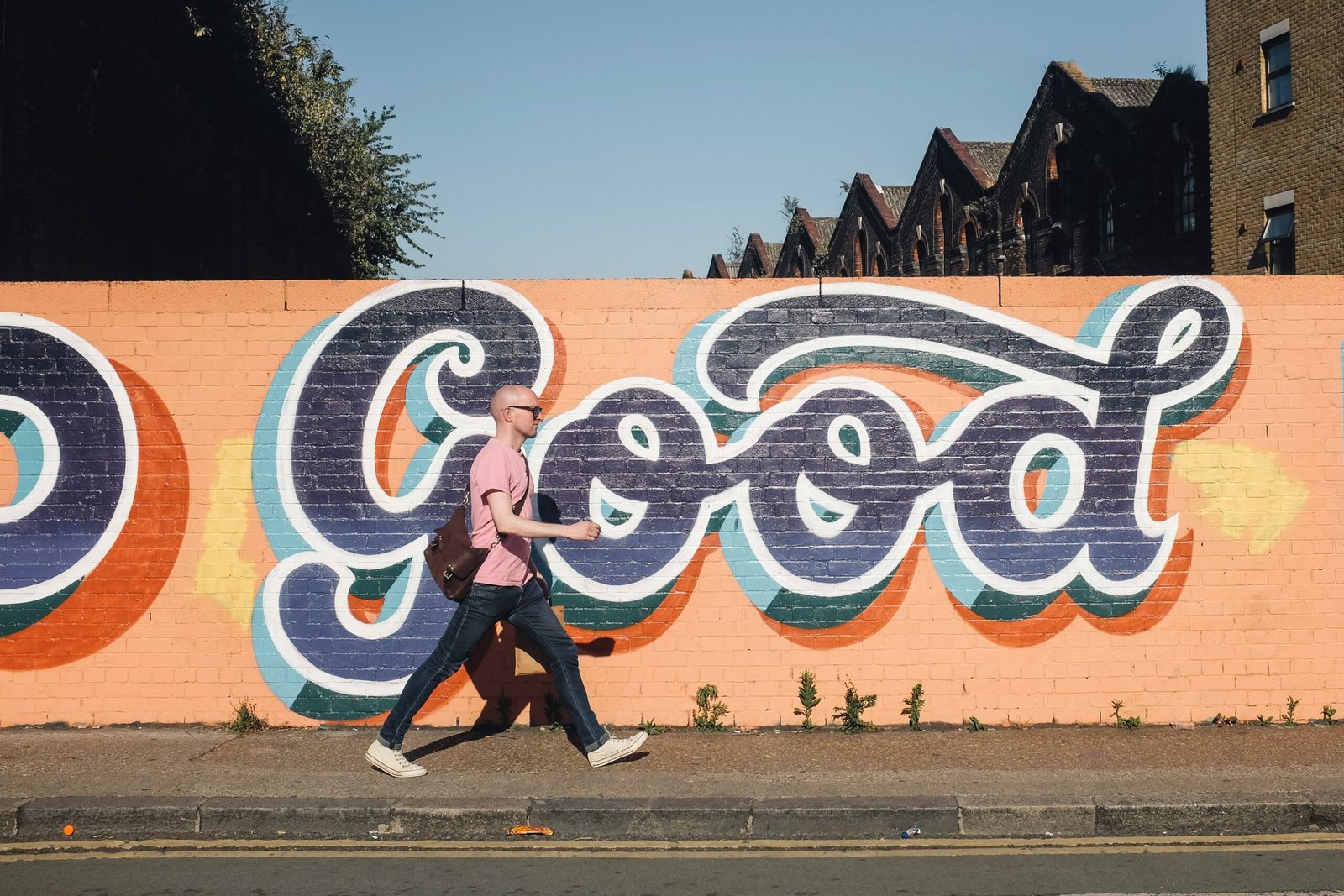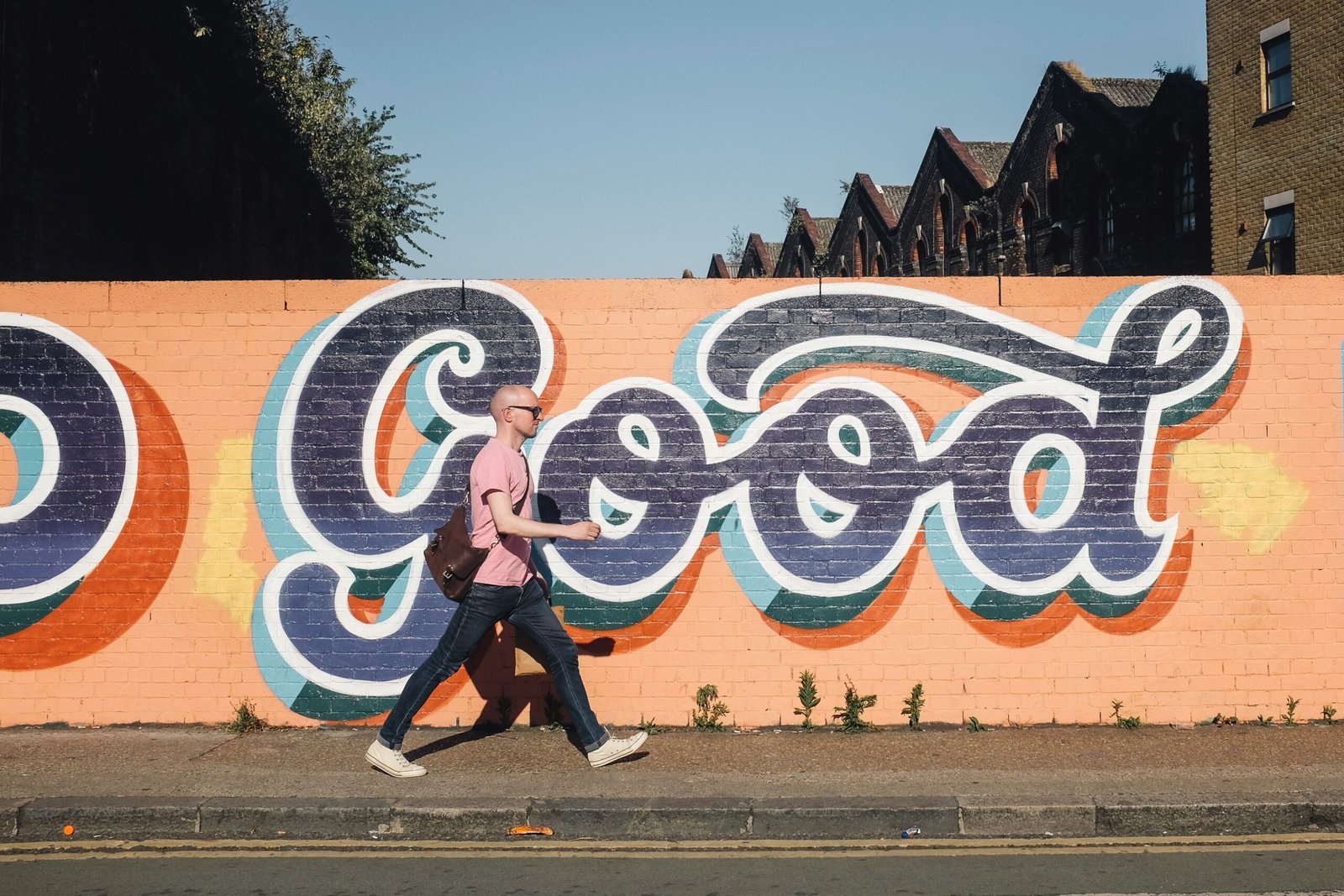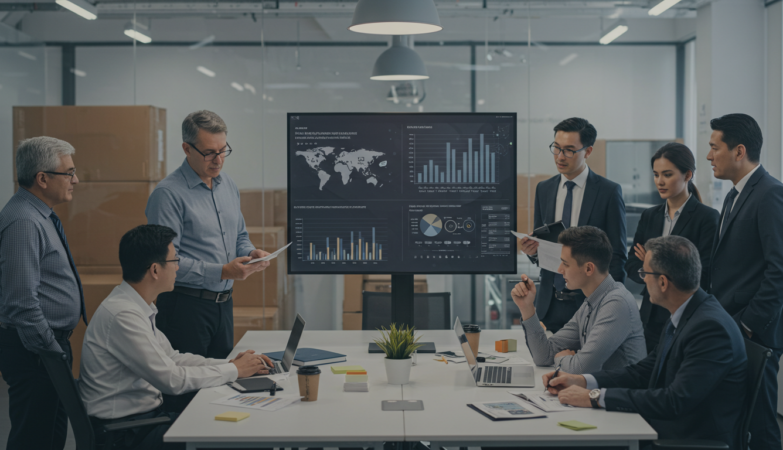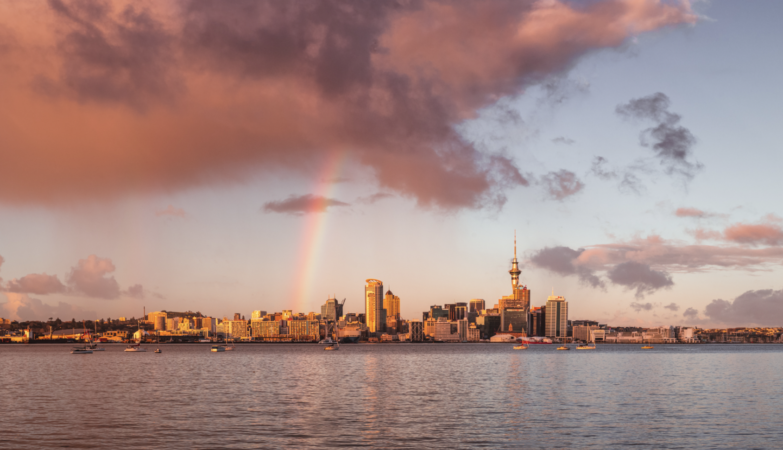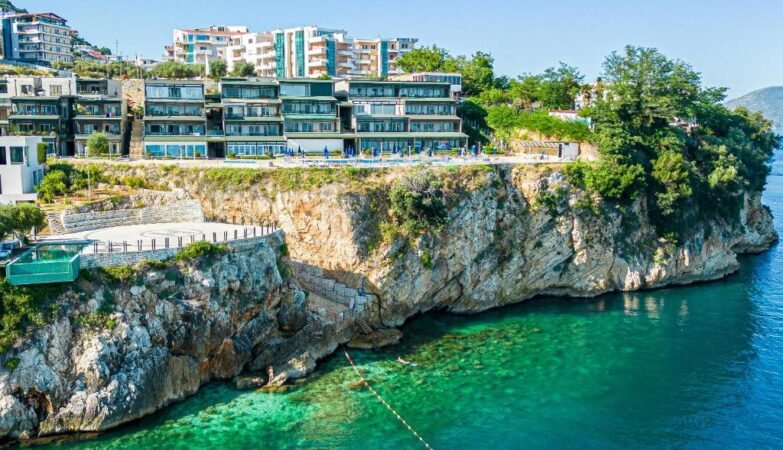Introduction to Urban Art in Berlin
Urban art in Berlin has evolved significantly over the past few decades, reflecting the city’s dynamic cultural landscape and complex historical context. Following the fall of the Berlin Wall in 1989, the city emerged as a vibrant canvas for artistic expression, attracting creatives from around the globe. This transformation was propelled by both the political shifts and the cultural openness of the time, fostering an environment where street art and graffiti could flourish.
The rich tapestry of urban art in Berlin is deeply intertwined with the city’s history. The reunification era introduced a wave of artistic innovation, as artists sought to reclaim and reinterpret public spaces that had been divided for years. Walls that once symbolized separation became platforms for profound artistic statements that addressed social, political, and personal themes. Consequently, urban art began serving not only as a visual spectacle but also as a form of dialogue within the community.
Berlin has become a global beacon for urban artists, largely due to its acceptance of diverse styles and fearless experimentation. The city’s eclectic neighborhoods, such as Kreuzberg and Friedrichshain, are home to an abundance of murals, stencils, and installations that exemplify the freedom of expression prevalent in the urban art scene. The cultural significance of this movement cannot be overstated; it provides a voice for marginalized communities and instigates conversations on pressing social issues.
Moreover, Berlin’s vibrant creative community actively nurtures emerging talent, offering numerous workshops and festivals that celebrate street art. This fosters a continuous cycle of innovation and reinvention, allowing urban art to remain relevant and impactful. As such, Berlin’s urban art scene is not merely a collection of artworks; it is a living testament to the city’s spirit of resilience, creativity, and community engagement.
The Essence of Berlin’s Lesser-Known Districts
Berlin, a city renowned for its vibrant art scene, extends beyond its main tourist attractions into the lesser-known districts that pulse with creativity. Areas like Wedding, Neukölln, and Lichtenberg are emerging as vital cultural landscapes where diverse communities coalesce, enabling an artistic atmosphere that inspires both established and emerging artists. These neighborhoods offer a unique blend of historical significance and contemporary energy, making them ideal canvases for art practice.
Wedding, once perceived as an overlooked district, has developed its identity, becoming a hub for street art and community-driven projects. Artists exploit the raw, industrial aesthetics of the area, transforming abandoned buildings into murals and installations that reflect local narratives. The blend of traditional and modern elements encourages a sense of authenticity that attracts creatives drawn to the freedom of expression.
Similarly, Neukölln has evolved into a multicultural mosaic, where diversity thrives and influences artistic expression. This district hosts a plethora of galleries and art studios that showcase an array of techniques and mediums. The cultural melting pot allows for collaborations between artists from different backgrounds, resulting in a dynamic exchange of ideas that enriches the local art scene. Activities such as open studios and art festivals foster community engagement, inviting residents to appreciate and participate in the arts.
Lichtenberg, often overlooked in favor of its more popular counterparts, boasts a unique heritage and architecture that provide a backdrop for artistic exploration. Its blend of residential neighborhoods and industrial areas creates spaces ripe for creativity, supporting both public art initiatives and grassroots projects. This inviting local atmosphere allows artists to flourish, making their mark in a district that celebrates individuality and artistic freedom.
In the synergy of these districts, we find an essence that cultivates creativity, making them integral parts of Berlin’s artistic identity.
Notable Urban Art Walks in Berlin
Berlin is renowned for its vibrant street art scene, but beyond the popular tourist destinations lie numerous lesser-known districts that are equally rich in urban artistry. Exploring these hidden gems can be a rewarding experience, especially through organized urban art walks or self-guided routes. One notable area worth visiting is Friedrichshain, which boasts an impressive array of murals and graffiti that reflect the community’s rebellious spirit and creative energy. Guided tours here, such as those led by local artists, often reveal the stories behind prominent works and provide insights into the city’s evolving street art culture.
Another district to consider is Neukölln, where the streets are adorned with a mix of colorful murals and thought-provoking installations. Self-guided tours can easily be explored on foot or by bicycle, and visitors can stop by hidden courtyards and alleyways that feature dynamic pieces from both established and emerging artists. Additionally, street art festivals like the ‘Urban Nation’ festival present an excellent opportunity to witness large-scale commissioned works that elevate the creative landscape. These festivals foster a spirit of collaboration, showcasing global talents alongside local artists.
In terms of practical tips, wearing comfortable shoes and being prepared for varying weather conditions is advisable when embarking on an urban art walk. Carrying a camera is also recommended to capture the stunning visual narratives that unfold throughout the districts. Engaging with local street art blogs can enhance the experience by providing context and updates on new installations and events. In conclusion, exploring urban art walks in Berlin’s lesser-known districts not only highlights the richness of the city’s artistic fabric but also promotes a deeper understanding of its cultural dynamics.
Street Art Murals: Stories Behind the Walls
Berlin, a city known for its vibrant culture and artistic expression, is adorned with street art murals that are not only visually stunning but deeply meaningful. These murals often act as narratives painted on the urban canvas, reflecting various themes related to social issues, cultural identity, and local histories. Each mural tells a different story, contributing to the rich tapestry that is Berlin’s lesser-known districts.
One notable mural, located in the district of Neukölln, vividly portrays the struggles and resilience of immigrants, a recurring theme in much of the city’s street art. This piece, painted by local artist El Bocho, speaks to the challenges faced by those who have relocated, as well as their contributions to the community. Through the use of vibrant colors and striking imagery, the artwork captures both the pain and hope intertwined in the immigrant experience, inviting viewers to contemplate these issues from a more informed perspective.
Another striking piece can be found in Friedrichshain, where a large mural addresses environmental issues and the importance of sustainability. Created by a collaborative group of artists, this mural serves as a visual reminder of the pressing challenges posed by climate change. The integration of natural elements and industrial motifs illustrates the tension between urban development and ecological preservation, prompting viewers to reflect on their responsibilities towards the environment.
Insights from the artists behind these murals emphasize the intention of their work; they aim to provoke thought and inspire dialogue among community members. By illustrating local narratives and social concerns, these artists foster a connection between the murals and the community, encouraging residents and visitors alike to engage with the issues represented. Ultimately, the stories behind Berlin’s street art murals extend beyond their surfaces, revealing a complex interplay of culture, identity, and activism in the urban landscape.
Interactive Urban Art Spaces
Berlin is renowned for its vibrant urban art scene, which extends well beyond the canvases of galleries and the murals adorning the city’s walls. Among the many offerings, interactive urban art spaces play a crucial role in fostering community engagement and participation. These venues—galleries, studios, and public parks—provide opportunities for local residents and artists to collaborate and innovate, making art accessible to a broader audience.
One notable example is the Haus der Kulturen der Welt, which regularly showcases rotating exhibitions that invite public interaction. Visitors can immerse themselves in the artistic process through workshops and discussions that enhance their understanding and appreciation of urban art. This space not only promotes creativity but also encourages an exchange of ideas among diverse communities.
Additionally, the Urban Nation Museum exemplifies an interactive approach to urban art. This museum is dedicated to the development of contemporary art in public spaces, offering various programs aimed at engaging visitors. By holding collaborative events and community workshops, Urban Nation fosters a sense of ownership among residents, empowering them to become active participants in the artistic landscape of their neighborhoods.
Public parks across Berlin are also transforming into interactive gallery spaces. Events such as murals in the parks allow local artists to showcase their work while engaging with the community. This not only beautifies public spaces but also creates opportunities for informal networking and collective creativity among local artists and residents.
In these interactive urban art spaces, the transformation of art from a mere observer experience to a participatory endeavor fosters creativity and collaboration. Through exhibitions, workshops, and community engagement, there lies a unique opportunity to enrich the cultural fabric of Berlin, highlighting the importance of collective artistic expression in fostering a convivial urban environment.
The Role of Street Art Collectives
Street art collectives play a vital role in shaping the urban art landscape of Berlin, particularly in its lesser-known districts. These groups, often comprised of local artists, curators, and activists, collaborate to create vibrant murals and installations that reflect the unique cultural tapestry of their neighborhoods. By promoting a sense of community and identity, they contribute significantly to the ever-evolving character of Berlin’s street art scene.
One of the primary functions of these collectives is to organize events that engage both artists and community members. Street art festivals, exhibitions, and workshops are frequently initiated by these groups, providing platforms for emerging talents to showcase their work. For instance, the Berlin Street Art Collective has organized numerous mural projects that not only beautify urban spaces but also draw in local residents and visitors, fostering a sense of pride and ownership in their surroundings.
Furthermore, street art collectives often collaborate with local businesses and organizations to tackle community issues. By addressing social concerns through their artwork, these collectives can create powerful statements that resonate with the public. A notable example is the partnership between the Friedrichshain-Kreuzberg Street Art Collective and local schools to create educational workshops focused on social justice themes. Through such initiatives, the collective not only enhances the urban environment but also empowers residents to engage in discussions about pressing societal issues.
Interviews with members of these collectives reveal a shared ethos of inclusivity and collaboration. As one artist noted, “Our work goes beyond just painting walls; it’s about creating dialogue and connection within the community.” This sentiment is echoed by many involved, showcasing how street art collectives are not only artists but also catalysts for change within Berlin’s diverse neighborhoods. Their influence is a testament to the power of creativity in uniting people and inspiring community engagement.
Gentrification and Urban Art: A Double-Edged Sword
The interplay between gentrification and urban art in Berlin’s lesser-known districts presents a complex landscape where economic development often conflicts with the preservation of cultural identity. As neighborhoods undergo transformation, attracting new residents and businesses, the rise in property values and rents can threaten the very spaces that foster artistic expression. Many artists find themselves in precarious positions, navigating the challenges of diminishing affordable studios and public spaces as the socio-economic dynamics shift.
Historically, urban art has served as a powerful medium for social commentary and community engagement. However, as these districts become increasingly popular, the original inhabitants and artists may be pushed out, leading to a phenomenon known as creative displacement. This situation raises pertinent questions about the sustainability of art in gentrifying areas. As the affordability of living conditions declines, the innovation and diversity that urban art brings to communities can suffer. The artists who once contributed to the cultural tapestry of these neighborhoods may no longer find the environment conducive to their craft.
Furthermore, the commercialization of urban art often brings a risk of diluting its authenticity. With local art and artists now serving as attractive features for developers aiming to market trendy new spaces, there is a danger that the original messages of resistance and community will be overshadowed. The challenge lies in finding a balance between the benefits that gentrification can provide—such as improved infrastructure and increased investment—and the urgent need to support and maintain the cultural essence of these lesser-known districts.
In conclusion, while gentrification can bring vitality and development, it is essential to remain vigilant about its impact on urban art. This balance is crucial for preserving cultural identity and ensuring that artistic communities continue to thrive amidst change.
How to Respect and Support Local Artists
Engaging with urban art in Berlin’s lesser-known districts requires a mindful approach that honors the efforts of local creators. It is essential to recognize that much of this art is a form of self-expression deeply intertwined with the community and its culture. One of the foremost ways to respect these artists is by understanding the legal landscape of street art. Many artists operate in a grey area where the legality of their work can be ambiguous. Always take the time to educate yourself on the legality of street art in specific areas, as this knowledge can help prevent inadvertent disrespect towards the creativity and labor involved in these artworks.
Furthermore, acknowledging the messages and stories behind the art can deepen your appreciation. Many artists aim to convey themes related to social issues, historical context, or personal narratives through their work. Engaging with this artwork, whether through guided tours or personal interaction, adds a layer of respect. If you choose to photograph or share these urban pieces online, consider properly attributing the artists when possible, as this practice not only pays homage to their work but also amplifies their voices.
Supporting local artists can take many forms beyond mere appreciation. Purchasing original artworks, prints, or merchandise directly from these creators can significantly contribute to their livelihood. Additionally, participating in community activities, such as workshops or local art shows, can foster a stronger connection between you and the artistic community. By attending events, you also help elevate the visibility of local artists, encouraging a thriving atmosphere where creativity flourishes.
By adopting these practices, you not only enjoy the vibrant urban art scene of Berlin but also contribute positively to the local artistic fabric, ensuring that the culture remains alive and accessible for everyone.
Conclusion and Future of Urban Art in Berlin
As we have explored throughout this post, Berlin’s lesser-known districts are a treasure trove of urban art, featuring diverse expressions that contribute significantly to the city’s vibrant culture. These areas not only offer a platform for artistic innovation but also serve as reflections of the communities that inhabit them. The murals, installations, and street art found in neighborhoods such as Neukölln and Wedding tell stories that resonate with both locals and visitors alike, often addressing social issues, identity, and the ever-changing urban landscape.
The future of urban art in Berlin appears promising as artists continue to push boundaries by experimenting with new techniques and mediums. With the rise of technology, we may see an increase in digital art and augmented reality, transforming how art interacts with public spaces. Moreover, as gentrification threatens some neighborhoods, the role of urban art could become even more crucial in preserving cultural narratives and fostering dialogue between residents and newcomers. This ongoing evolution hints at a dynamic, ever-changing dialogue that art can facilitate within the urban environment.
Engaging with urban art not only enriches our understanding of local cultures but also empowers communities by elevating their voices. Readers are encouraged to participate in urban art walks, where they can directly experience the impressive talent of Berlin’s artists while supporting local initiatives that aim to sustain and nurture this creative realm. As we look ahead, urban art is likely to remain a critical force, inspiring social change and igniting conversations around community identity. Thus, embracing the art found in Berlin’s lesser-known districts can lead to profound insights and a greater appreciation for the power of creative expression in shaping the city’s future.
